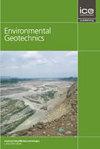柔性路面下交通荷载引起土体永久变形的计算方法
IF 2.2
4区 工程技术
Q3 ENGINEERING, GEOLOGICAL
引用次数: 0
摘要
车辙是柔性路面结构中最常见的病害类型之一。路面结构设计有两种基本方法:传统的经验方法和分析方法。许多分析和经验设计程序假设车辙主要是由沥青引起的,可以通过限制路基顶部的垂直变形或应力来减少车辙,但它们没有量化车辙深度本身。预测无粘结路面层永久变形的力学经验模型已经得到了很好的研究,并且在北美相当普遍;然而,它们在世界其他地区并未得到广泛应用。到目前为止,还没有一个被普遍接受、广泛认可和记录在案的程序来计算永久变形,从而确定源于松散颗粒层的柔性路面的车辙深度。本文提出了一种分层计算方法,可以确定柔性路面下土层(基层、下层和路基)在重复交通荷载作用下的变形。在第一步中,使用基于粒径分布参数(d50和CU)并依赖于平均法向应力、相对密度和实际应变水平的非线性材料模型计算循环应变幅值。第二步,采用HCA (High Cycle Accumulation)模型计算各子层的残余沉降作为循环次数的函数。结果表明,所建立的模型适用于描述不同类型的路基和路面断面。通过有限元计算表明,所建立的模型能够较准确地描述弹性应变和塑性应变。该模型基于易于获取的粒径分布参数,无需进行复杂的实验室和有限元试验,即可较准确地预测路面结构的沉降和车辙。本文章由计算机程序翻译,如有差异,请以英文原文为准。
Calculation Method for Traffic Load-Induced Permanent Deformation in Soils under Flexible Pavements
Rutting is one of the most common types of distress in flexible pavement structures. There are two fundamental methods of designing pavement structures: conventional empirical methods and analytical approaches. Many analytical and empirical design procedures assume that rutting is mostly of asphalt origin and can be reduced by limiting the vertical deformation or stress at the top of the subgrade, but they do not quantify the rutting depth itself. Mechanistic–empirical models to predict the permanent deformations of unbound pavement layers have been well investigated and are rather common in North America; however, they are not widely utilized in the rest of the world. To date, there is no generally accepted, widely recognized, and documented procedure for calculating permanent deformations and thus for determining the rutting depth in flexible pavement courses originating from the unbound granular layers. This paper presents a layered calculation method with which the deformation of soil layers (base, subbase, and subgrade courses) under flexible pavements due to repeated traffic load can be determined. In the first step, the cyclic strain amplitude is calculated using a nonlinear material model that is based on particle size distribution parameters (d50 and CU) and dependent on the mean normal stress, relative density, and actual strain level. In the second step, the HCA (High Cycle Accumulation) model is used to calculate the residual settlement of each sublayer as a function of the number of cycles. It is shown that the developed model is suitable for describing different types of subgrades and pavement cross-sections. It is also demonstrated with finite element calculations that the developed model describes both the elastic and plastic strains sufficiently accurately. The developed model can predict the settlement and rutting of pavement structures with sufficient accuracy based on easily available particle size distribution parameters without the need for complex laboratory and finite element tests.
求助全文
通过发布文献求助,成功后即可免费获取论文全文。
去求助
来源期刊

Environmental geotechnics
Environmental Science-Water Science and Technology
CiteScore
6.20
自引率
18.20%
发文量
53
期刊介绍:
In 21st century living, engineers and researchers need to deal with growing problems related to climate change, oil and water storage, handling, storage and disposal of toxic and hazardous wastes, remediation of contaminated sites, sustainable development and energy derived from the ground.
Environmental Geotechnics aims to disseminate knowledge and provides a fresh perspective regarding the basic concepts, theory, techniques and field applicability of innovative testing and analysis methodologies and engineering practices in geoenvironmental engineering.
The journal''s Editor in Chief is a Member of the Committee on Publication Ethics.
All relevant papers are carefully considered, vetted by a distinguished team of international experts and rapidly published. Full research papers, short communications and comprehensive review articles are published under the following broad subject categories:
geochemistry and geohydrology,
soil and rock physics, biological processes in soil, soil-atmosphere interaction,
electrical, electromagnetic and thermal characteristics of porous media,
waste management, utilization of wastes, multiphase science, landslide wasting,
soil and water conservation,
sensor development and applications,
the impact of climatic changes on geoenvironmental, geothermal/ground-source energy, carbon sequestration, oil and gas extraction techniques,
uncertainty, reliability and risk, monitoring and forensic geotechnics.
 求助内容:
求助内容: 应助结果提醒方式:
应助结果提醒方式:


